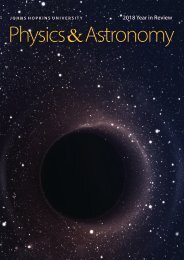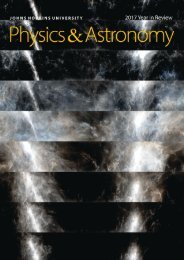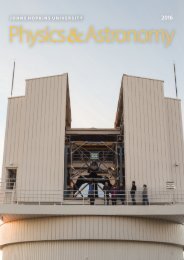2019_PA_Newsletter
2019 Year-in-Review
2019 Year-in-Review
You also want an ePaper? Increase the reach of your titles
YUMPU automatically turns print PDFs into web optimized ePapers that Google loves.
What Gives Animal Cells Their Agency?
Yu Shi, Dan Reich, et al. Measure Cytoskeletal Fluctuations
Recent Ph. D. graduate Yu Shi was the
lead author of a paper published in the
Proceedings of the National Academy of
Sciences in 2019 that examines cellular
dynamics. The ability of animal cells to crawl,
change their shape, and respond to applied
force is due to their cytoskeleton: a dynamic,
cross-linked network of actin protein
filaments and myosin motors. Shi, along with
Professor Daniel Reich, and two co-authors
from the University of Pennsylvania, created
a method using micropost arrays to measure
cytoskeletal motion, forces, and rheology
with high precision and statistical power,
employing substrates containing arrays
of flexible microscopic posts. The team’s
results show that motion of the cytoskeletal
network is dominated by rare large events
and imply that future models of cytoskeletal
dynamics may need to incorporate the
concepts of jamming, self-organization and
mechanical marginality, phenomena similar
to those seen in avalanches and earthquakes.
The paper is titled “Dissecting fat-tailed
fluctuations in the cytoskeleton with active
micropost arrays.”
Confocal microscopy imaging of two cells,
cytoskeletal proteins in red, nucleus in blue.
Credit: Drima Film
Above: An image from Shi’s paper of 3T3 fibroblasts
immunostained for actin (green) and nuclei (blue ).
Right: Yu Shi toasts with his thesis advisor, Professor
Daniel Reich, after earning his Ph. D. in December 2019,
Photo Credit: Jon Schroeder
JOHNS HOPKINS UNIVERSITY PHYSICS AND ASTRONOMY YEAR IN REVIEW 2019 9










